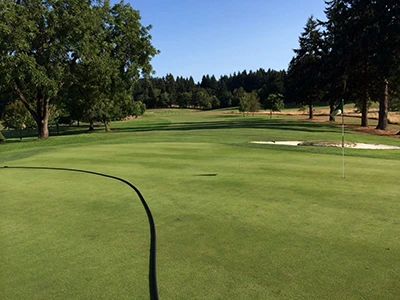
Laurelwood Golf Course in Eugene, Ore., is a bit different from other courses, says superintendent Will Benson. The nine-hole municipal course is surrounded by environmentally conscious neighbors, who became increasingly concerned about inputs a few years ago. Unfortunately for Benson, that was right around the time the recession hit Eugene.
“Out here, we were kind of the last ones in the recession, and we’re the last ones coming out,” says Benson. “We weren’t spending anything. We were just trying to keep alive.”
With a staff of about four, Benson had to face about a 75 percent budget cut from the city, he says, and still maintain the course and driving range. The city also had some things to say about fertilizer use, guided by those same neighbors. Up to that point, Benson had been using a standard input program, but he had to deal with a brand-new, very aggressive plan. He was severely restricted not just in what products he could use, but in how much he could afford. When the budget was cut, his focus initially was in keeping up his equipment and bringing along the input program where he could.
“I kind of had to learn to find a different way to go about things,” he says. “The plan, it just went on and on. Then the two hit at the same time, then you’re really screwed. You’re attempting to learn a whole new way of caring for the turfgrass without just a regular routine. It’s a whole re-education process.”
While some superintendents make a choice to try out new inputs in test plots and get opinions from peers and results from university studies, the new plan didn’t give him much of a chance. He went headlong into trying out new programs – mostly organic with a compost tea to match the city’s restrictions – until he found some things that worked. It worked better at some times than others.
After losing the money and clearance to use his usual fertilizers, he switched to an organic fertilizer for the fairways. The company provided signs for the course describing the ingredients, which helped put the neighbors at ease. When it came to the greens, he tested as much as he could. But much of the time, it was a live experiment.
“The last three years, I’ve been experimenting pretty heavily. I would say this year, we’ve settled into a pretty good routine,” Benson says. “We got to know how far we could go before we started killing stuff. We got pretty good at killing stuff, and now we’re a lot better at not killing it.”
He’s been using a biostimulant for greens, with methylene urea and a few additives he’s developed – with ingredients derived from fish, kelp or molasses. Though he’s not certain exactly how the mix has changed the turf and soil, something’s different, he says. It’s not uncommon now for him to have roots six to eight inches down on the greens. He’s continued to fine-tune his results with different amounts of biostimulant inputs, and supplements with synthetics only when he thinks really necessary.
The change in input plans has been good for the course, says Benson. Since he’s required to post in the surrounding neighborhood whenever he’s spraying anything, the accountability has been positive PR for Laurelwood. And he can explain what he’s putting down to the players and city much better now because he’s spent so much time looking into it himself and developing the program.
As the recession has lifted, though, Benson has seen a little more leeway – not so much in his input restrictions as with his budget. The city finally agreed to a new business model, and he has a little more freedom to function when choosing what to put down. Last year, he spent about $14,500 on inputs. This year, he has about $17,000 to work with. Wetting agents on tees, fairways and surrounds will help him stretch water consumption on the course as well.
“We’ve done better with the course. We’ve started bringing it back,” says Benson. “The pressure, the money’s been easing up in the last few years. We’re trying to do everything in a different way now, because we really can’t do things the way we used to.”
He’s not looking at huge changes, but he’s open to trying new things now, after having no choice a few years ago. This year, he plans to do more soil testing and really take a look at how the turf has changed in the past three years – and he keeps an eye on new inputs and innovations to see if they match his goals for the course.
“I think we’re going to spend most of our time trying to quantify what works, doing some more soil tests this year,” says Benson. “We’re doing those and biological soil tests to inspect and keep track of what’s happening. It’s been a three-year experiment, and at this point, I think we’ve kind of got it nailed down, what we do.”
Latest from Golf Course Industry
- From the publisher’s pen: Conscientious of a bigger role
- Bernhard and Company partners with Laguna Golf Phuket
- Terre Blanche showcases environmental stewardship
- VIDEO: Introducing our December issue
- Bernhard and Company introduces Soil Scout
- Nu-Pipe donates to GCSAA Foundation’s Centennial Campaign
- GCSAA enhances golf course BMP tool
- Melrose leadership programs sending 18 to 2026 GCSAA Conference and Trade Show





